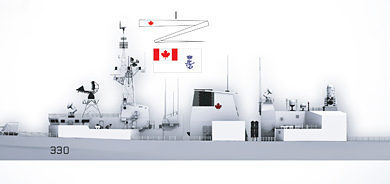Jetties, Piers and Wharfs
References: A. Harbours, Piers & Wharfs, Pile Buck, 1990
B. Breakwaters, Jetties, Bulkheads & Seawalls, Pile Buck, 1992
The terms pier, jetty and wharf are often used interchangeably by the media, public and even personnel of the Royal Canadian Navy. However, there is a separate definition for each. Definitions differ between Canadian/British English and American English; the former are used below.
Jetty: a marine structure, usually built perpendicular to the shore, extending out into the water to direct and confine a stream or tidal flow to a selected channel and to prevent or reduce scour or shoaling of that channel. Jetties can also be built to protect inlet channels from cross currents or storm waves.
Pier: a berthing structure that runs perpendicular (or at an angle) to the shore and projects out into the water.
Wharf: a berthing structure that runs parallel to the shore. When the wharf is connected to the shore along its full length it is called a marginal wharf.
Quay (or quai): a structure that ties two wharves or piers together along the shore line.
At times a jetty, pier or wharf is referred to as a dock. The technically correct terms are pier or wharf. Berthing structures in Her Majesty’s Canadian Dockyards are called jetties whatever their real form. The reasons are for sake of convenience and to make clear to non-engineering authorities in Ottawa, especially those with budgetary control, that there is really a single “real property asset class.”
Wharfs and piers can be constructed many different ways. Besides by using piles, they could be built using caissons (concrete boxes sunk on a rock mattress on the sea floor), sheet pile wall (steel sheets driven into the sea bed and tied back to deadmen or anchors into the existing fill on shore), or even timber or concrete cribs.
‘Berth’ is the technically correct term for the area alongside a pier or wharf where a ship is secured (tied up). Frequently civilians will use the terms docking and berthing interchangeably to refer to the act of a ship going from its own power in navigable waters to rest alongside a pier or wharf where she is secured. In the Navy, docking means to place a ship in a drydock or wetdock, or to take her out of the water on a lift.
Docks can be dry or wet. Dry docks are of two basic types: floating and graving. Floating drydocks may be moved from place to place and are suitable for servicing smaller ships and submarines. A floating drydock must be moored or anchored in a location where the water is considerably deeper than the draft of the ships it serves. A graving drydock is a permanently placed facility dug into the shoreline. A caisson gate is installed at the open end of the graving dock once a ship is placed inside and then the water is pumped out of the cavity so the ship can be worked on. Keel blocks are installed at the bottom of the graving dock prior to placing the ship inside and pumping out water. A wet dock is a variant in which the water is impounded either by dock gates or by a lock, thus allowing ships to remain afloat at low tide in places with high tidal ranges.
Use of correct terminology may become more important as progress is made with and interest increases on the new jetty being built in the Halifax Harbour Narrows as part of the Arctic and Offshore Patrol Ship project.
Photo: Wharfs of Her Majesty’s Canadian Dockyard Halifax, undated drawing, Naval Museum of Halifax




